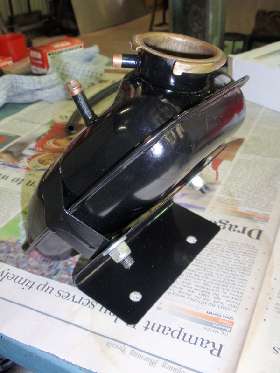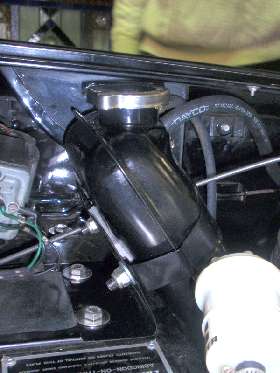The MGA With An Attitude
COOLANT RECOVERY SYSTEM, Pressurized - CO-204A
Prerequisite for this article is to read article CO-204 on the non-pressurized recover system. The pressurized system works in a different manner with the remote tank working same as the pressurized top tank on the normal radiator (and it needs a high pressure connector hose in between). For the MGA this is redundant except for one detail. The radiator filler neck is extended rearward from the top tank making it difficult to see fluid level in the radiator when you remove the pressure cap. This remote pressure tank positions the pressure cap directly over the fluid where it is easy to verify that there is enough fluid in the system. The remote pressure tank was only used on the MGB from 1977 on when the radiator did not have a filler cap. In more modern cars it is used for the same reason when a low profile radiator is used under a low hood (bonnet) line.
 
Photos courtesy of Thomas Aczel in New South Wales, Australia
Here the late model MGB remote fluid tank is mounted on the front edge of the MGA heater shelf with a simple fabricated bracket. A small bore hose runs from the radiator overflow pipe to the remote tank, and a second hose serves to divert any overflow from the remote tank to the ground. The connection pipe on the side of the tank actually runs to the bottom of the tank inside. This will work in either pressurized or non-pressurized mode. In any case you must have only one pressure cap.
You can use a blanking cap on the radiator and a standard pressure cap on the remote tank. This requires a high pressure (reinforced) connecting hose. The remote tank works the same as the normal top tank and pressure cap, and you still have to remove the pressure cap (when cool) to check fluid level.
You can use a pressure cap on the radiator and a blanking cap on the remote tank. This requires a coolant recovery type cap on the radiator with a rubber seal at the top rim of the filler neck (see prior article). This directs fluid through the connecting hose and also allows a slight vacuum to pull fluid back into the radiator with thermal contraction. This does not require high pressure hose, or high pressure reservoir. If you use a see-through remote reservoir you can see fluid level at a glance (prior article).
I have been using a non-pressurized see-through bottle on my MGA for many years, to make it easy to monitor coolant level. The bottle I use is larger than necessary. A copy of the original (optional) windscreen washer fluid bottle may serve as well. Otherwise the metal tank has a certain appeal in appearance for the MGA where very little plastic was used originally anywhere on the car. The metal tank may also last forever where a plastic bottle may not quite make a lifetime (depending on how long you live).
|

